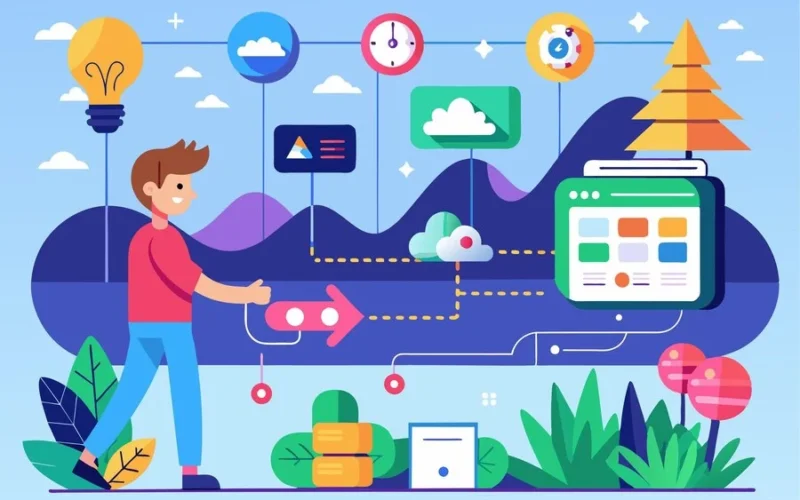Introduction
In today’s fast-paced world, automation has revolutionized the way we handle tasks, both personal and professional. With the rise of no-code tools, automating processes no longer requires coding expertise. These tools empower individuals to streamline their lives by simplifying repetitive tasks and optimizing workflows, saving both time and effort. Whether managing daily tasks or optimizing work processes, no-code tools can make your life easier and more efficient. In this article, we’ll explore how you can automate your life with no-code tools, offering practical tips, examples, and recommendations.Learn more about the power of automation in business here
What Are No-Code Tools?
No-code tools are software platforms that allow you to automate workflows, create applications, and build complex processes without writing a single line of code. These tools offer user-friendly, drag-and-drop interfaces, pre-built templates, and integrations with popular apps. They allow individuals, even those with no technical background, to create tailored solutions to their everyday problems.
Some popular no-code tools include:
- Zapier: Automates workflows by connecting apps and services.
- Airtable: Combines the functionality of a spreadsheet and database to manage and organize data.
- IFTTT: Stands for “If This Then That” and helps automate simple tasks between apps.
- Notion: A versatile tool for task management, project planning, and database organization.
- Bubble: A platform for building custom web applications without code.
Benefits of Automating Your Life with No-Code Tools
Automating your life with no-code tools offers numerous benefits:
- Saves Time: By automating repetitive tasks, you can focus on higher-value activities that require creativity or decision-making.
- Reduces Errors: Automation minimizes human errors, particularly in data entry and communication.
- Enhances Productivity: Streamlined workflows ensure tasks are completed efficiently and on time.
- Cost-Effective: No-code tools eliminate the need to hire developers, making automation accessible at a fraction of the cost.
- Customizable: Tailor automations to your specific needs and workflows, rather than relying on off-the-shelf solutions.
Practical Ways to Automate Your Life with No-Code Tools
Automate Daily Tasks
Tools to Use: IFTTT, Zapier
Daily routines often involve repetitive tasks, such as sending emails, posting on social media, or creating reminders. Tools like IFTTT and Zapier help you automate these tasks, saving time and effort.Examples:
- Automatically send a “Good Morning” message to a Slack channel.
- Save email attachments to Google Drive.
- Create calendar events from emails.
Step-by-Step Guide:
- Identify repetitive tasks in your day-to-day life.
- Choose a no-code tool (e.g., IFTTT, Zapier) that integrates with the apps you use.
- Set up workflows by selecting triggers (e.g., receiving an email) and actions (e.g., saving the attachment).
Streamline Work Processes
Tools to Use: Airtable, Notion, Trello
Automate work-related tasks such as project management, team collaboration, and data tracking.Examples:
- Use Airtable to manage projects with automated updates.
- Automate task assignments in Trello when project statuses change.
- Automatically generate meeting notes in Notion from calendar events.
Step-by-Step Guide:
- Define your work processes and identify bottlenecks.
- Choose a tool like Airtable or Notion for project management.
- Set up automations to handle task updates, reminders, and reporting.
Optimize Personal Finances
Tools to Use: YNAB (You Need a Budget), Zapier
Managing finances can be tedious, but no-code tools can help you automate everything from tracking expenses to categorizing spending and saving.Examples:
- Automatically log transactions into a spreadsheet.
- Receive notifications when you exceed your spending limits.
- Move a set amount of money into a savings account every month.
Step-by-Step Guide:
- Link your financial accounts to a tool like YNAB or Zapier.
- Create workflows that categorize transactions and track expenses.
- Set up alerts for unusual spending patterns or to remind you of financial goals.
Build Custom Applications
Tools to Use: Bubble, Glide
No-code platforms like Bubble and Glide allow you to create custom applications without any coding knowledge.Examples:
- Build a budgeting app tailored to your financial habits.
- Create a client management app for your freelance business.
- Design a personal to-do list app.
Step-by-Step Guide:
- Define the purpose and features of your app.
- Use Bubble or Glide to design and build the app.
- Integrate your app with other tools as needed.
Automate Communication
Tools to Use: Mailchimp, Twilio, Zapier
Automating communication saves time and ensures consistent messaging, whether it’s for personal or professional purposes.Examples:
- Send automated follow-up emails with Mailchimp.
- Schedule and send text message reminders with Twilio.
- Notify your team of important updates via Slack.
Step-by-Step Guide:
- Choose the right platform for your communication needs.
- Create templates for emails or messages.
- Set up triggers and schedules to automate communication.
Improve Health and Wellness
Tools to Use: Google Fit, MyFitnessPal, IFTTT
Automation isn’t just for work—it can also help you stay healthy by tracking fitness, logging meals, and reminding you to stay active.Examples:
- Sync workout data from your fitness tracker to Google Sheets.
- Receive reminders to drink water or take a walk.
- Log calorie intake directly from meals into a fitness app.
Step-by-Step Guide:
- Connect your fitness apps to automation platforms like IFTTT.
- Set up workflows to track health data and log activities.
- Create reminders for healthy habits and wellness goals.
Automate Smart Home Devices
Tools to Use: SmartThings, Alexa, Google Home
Smart home technology can automate everyday tasks like controlling lights, adjusting thermostats, or managing security systems.Examples:
- Turn on lights when you enter a room.
- Schedule your thermostat to adjust based on time of day.
- Receive alerts for unusual activity detected by security cameras.
Step-by-Step Guide:
- Set up your smart devices and connect them to a central hub.
- Use automation platforms like SmartThings or IFTTT to create routines.
- Test and adjust automations to optimize performance.
Getting Started with No-Code Automation
To get started with no-code automation, follow these steps:
- Identify Tasks to Automate: Look for repetitive tasks in your personal and professional life that can be streamlined.
- Choose the Right Tools: Research no-code tools that align with your automation goals.
- Start Small: Begin by automating simple tasks and gradually expand as you become more comfortable.
- Leverage Templates: Many tools provide pre-built templates, which can save time and help you get started quickly.
- Iterate and Optimize: Regularly review and optimize your automations for greater efficiency.
The Future of No-Code Automation
As no-code tools continue to evolve, their potential for personal and professional use will expand. Emerging trends such as AI-powered automation, enhanced integrations, and user-friendly interfaces promise to make no-code platforms even more accessible and powerful. By embracing these tools, you can save time, increase efficiency, and unlock new creative possibilities that were once the domain of developers.
Conclusion
No-code tools are changing the way we approach automation. Whether you’re managing daily tasks, optimizing work processes, improving personal finances, or building custom applications, no-code tools can help you automate various aspects of your life. By leveraging these tools, you can save time, reduce errors, and boost your productivity—all without needing to write a single line of code. The possibilities are endless, and as no-code tools continue to advance, the future of automation looks brighter than ever.

